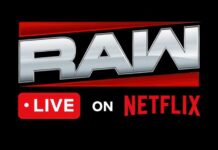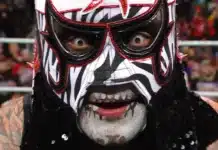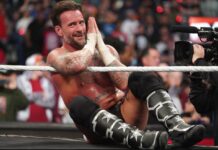With today being the 20-year anniversary of Owen Hart’s death, former WWE photographer Tom Buchanan wrote the following blog on Facebook:
A long post for my wrestling friends…
Twenty years ago today professional wrestler Owen Hart was killed by a poorly rigged stunt during a live pay per view in Kansas City. I was working as a WWF/WWE ringside photographer that night when Owen fell 80 feet from the overhead catwalk and landed just 20 feet away. It was a horrible moment and a painful night that just never seemed to end. And twenty years later, May 23, 1999 remains the worst night of my life.
Once the pay per view was over I was asked to photograph the police investigation. I was a logical choice for the task because I regularly did production rigging of WWF/WWE photography lighting; was active in sport rock climbing and a nationally certified skydiving instructor; and was licensed by the Federal Aviation Administration as a Senior Parachute Rigger. Plus, I had been working for WWF/WWE for more than ten years and had been a consistent advocate to management about safety issues, and I had photographed several prior accidents during WWF/WWE productions.
The photo accompanying [see below] this post is of sample hardware I purchased to show Vince McMahon what went wrong. This hardware is a different brand than what was used to suspend Owen, but it is functionally identical. The bottom silver piece is a “shackle” and the top silver piece is a spring-loaded “snap shackle.” The shackle was attached to a harness Owen was wearing, and the snap shackle was attached to a rope that suspended him above ring. The red line represents the rope that ran from the snap shackle to the catwalk, and the green line represents a release cord running from the snap shackle along Owen’s side to a small grip/hand release. Owen was to have been lowered to the wrestling ring and then pull the hand release which would open the snap shackle and allow him to step away from the rope. Somehow the snap shackle opened when Owen was being staged for the stunt, while he was suspended alongside the catwalk 80 feet in the air.
Initial thinking on the night of the accident was that Owen may have accidentally grabbed the release line in fear as he hung above the ring (in spite of it reportedly being securely taped to his harness), but my experimentation with the sample hardware a few days later led me to believe the heavy cape/robe Owen was wearing pressed on an inappropriately taught section of the release line between the snap shackle and his shoulder, and when Owen felt his robe slipping or being lifted up by the line he grabbed at the robe, which further pressured the release line causing the snap shackle to open.
It shocked me that a professional rigger would fly a wrestler with no stunt experience using just a single snap shackle without any back-up. When the rest of our crew learned how the stunt had been rigged they were equally aghast. By then our crew was mature enough that we wouldn’t have hung a tiny light fixture with a single snap shackle, let alone a human being. This accident should never have happened, and probably wouldn’t have happened if any of the WWF/WWE riggers had even a whiff of how Bobby Talbert, a newly hired independent contractor, was planning to rig the stunt. Mr. Talbert had apparently been involved in a similar stunt with WCW wrestler “Sting,” and has since had a very successful career as a Hollywood stunt rigger and performer (see his profile on IMDb).
I spent several hours in the Kansas City arena with the police after the pay per view, and went to the police station to photograph the harness. Then I began a long drive to Saint Louis for the next day’s WWF/WWE television show. I stopped at a small hotel for the night midway between the two towns and before going to bed I prepared notes about what had happened. I recently stumbled on my computer notes written in an outdated file format, which has since been converted to a readable Word document.
Here are a few excerpts:
>>>>>>>>>>>>>
5/23/99 “The drop area was located along a catwalk in the center of the building over the ring. The area had been draped with black cloth so the crowd would not see Owen as he prepared for the stunt. The cloth was taped in place with white and blue tape that appeared to be used for covering ring ropes. The rigging was visible and could be accessed from the catwalk. Everything appeared to be as it had been left. There was an open snap shackle hanging down supported by an extensive series of spansets and shackles. I photographed the equipment from many angles as did the police. Mr. Talbert demonstrated how the snap shackle was attached to Owen, and how the release cord had been positioned on his harness. Mr. Talbert said the release had been taped on his right side. I photographed this demonstration. Following the demonstration I operated the snap shackle six times and it seemed to be in good condition. Mr. Talbert said it all the components he used were new, and that he had the receipt downstairs if we needed to see it. He also said all the equipment had been purchased by WCW. He then noted that he had actually purchased the equipment, but that it had been charged to WCW as an expense item. He said this was the same type of equipment used by WCW for the Sting drop, and was actually purchased as part of that production. Mr. Talbert said that he had attached the snap shackle to Owen while he was on the cat walk, and that he loaded the shackle immediately by lifting on the rope. He then had Owen climb over the catwalk onto a beam and squat down so the full rig was loaded. When he was comfortable with the security of the equipment, Bobby Talbert had Owen step off the steel and hung in the harness. He said everything appeared normal at that time. Several seconds later Mr. Talbert said he started lowering Owen to get him clear of the steel and ready for the stunt. At that time he said Owen reached in to his chest area, perhaps to adjust his cape. Mr. Talbert said he could not see the release line or if Owen grabbed the line because it was covered by the cape, and that Owen seemed to be grabbing at the cape. Mr. Talbert said that suddenly, and without warning, the shackle released and Owen fell. He said that Owen fell for more than five seconds before hitting the ring, and that he did not say anything as he fell. Mr. Talbert speculated that Owen was attempting to move his cape out of the way and grabbed the release line by mistake. Mr. Talbert said that the only person on the catwalk other than Owen and himself was a building rigger named Scott.”
>>>>>>>>>>>>>>>>>>>
5/23/99 “After the catwalk inspection I asked the crime scene technicians if I could also photograph the harness. They said that had been left at the lab, and they then received authorization from the detective in charge to take me to the lab and let me photograph the harness. I followed the police to their office. [One of the officers] brought the harness from the lab to an office area where I photographed it. I recognized the harness as the same one Owen had been wearing earlier in the day. The harness had been cut at the leg straps and the vertical lift webs. Other than the cuts it appeared to be in new condition. There was no tape visible on the front or back of the harness.”
>>>>>>>>>>>>>>>
5/24/99 “I started the day by visiting a marine supply store on my way to St. Louis. I purchased a shackle, a snap shackle, a ring, and some rope line. I assembled the components in the same way the rigging had been set for Owen so I could easily explain to Vince McMahon what had happened. The cost of the hardware was 52.12.”
“When I arrived in St. Louis at about 11:00 AM I handed the two rolls of print film to [a WWF staffer] who had a production runner take the film to Wolf Camera for processing. The runner returned the processed film at approximately 1:30 PM.”
“When I had the prints back I met briefly with Vince McMahon. He was distraught and not interested in a detailed briefing of the rigging, nor was he interested in a demonstration of how a snap shackle works, or looking at the photographs. I gave him a quick briefing that concluded Owen most likely activated the release himself either when moving his cape, or while clutching his harness.”







